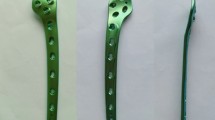Abstract
Background: The purpose of this study was to compare the resistance of intramedullary single screw device (Gamma nail) and double screw device proximal femoral nail (PFN) in unstable trochanteric fractures in terms of the number of cycles sustained, subsidence and implant failure in an axial loading test in cadaveric femora.
Materials and Methods: The study was conducted on 18 dry cadaveric femoral specimens, 9 of these were implanted with a Gamma nail and 9 with PFN. There was no significant difference found in average dual energy X-ray absorptiometry value between both groups. The construct was made unstable (AO type 31A3.3) by removing a standard sized posteromedial wedge. These were tested on a cyclic physiological loading machine at 1 cycle/s with a load of 200 kg. The test was observed for 50,000 loading cycles or until implant failure, whichever occurred earlier. Peak displacements were measured and analysis was done to determine construct stiffness and gap micromotion in axial loading.
Result: It was observed that there was statistically significant difference in terms of displacement at the fracture gap and overall construct stiffness of specimens of both groups. PFN construct group showed a mean subsidence of 1.02 mm and Gamma nail construct group showed mean subsidence of 2.36 mm after cycling. The average stiffness of Gamma nail group was 62.8 ± 8.4 N/mm which was significantly lower than average stiffness of the PFN group (80.4 ± 5.9 N/mm) (P = 0.03). In fatigue testing, 1 out of 9 PFN bone construct failed, while 5 of 9 Gamma nail bone construct failed.
Conclusion: When considering micromotion (subsidence) and incidence of implant/screw failure, double screw device (PFN) had statistically significant lower micromotion across the fracture gap with axial compression and lower incidence of implant failure. Hence, double screw device (PFN) construct had higher stability compared to single screw device (GN) in an unstable trochanteric fracture femur model.
Similar content being viewed by others
References
Friedl W, Clausen J. Experimental examination for optimized stabilisation of trochanteric femur fractures, intra or extra medullary implant localisation and influence of femur neck component profile on cut-out risk. Chirurg 2001;72:1344–52.
Baumgaertner MR, Curtin SL, Lindskog DM. Intramedullary versus extra medullary fixation for the treatment of intertrochanteric hip fractures. Clin Orthop Relat Res 1998;348:87–94.
Buciuto R, Hammer R. RAB-plate versus sliding hip screw for unstable trochanteric hip fractures: Stability of the fixation and modes of failure: Radiographic analysis of 218 fractures. J Trauma 2001;50:545–50.
Xu Y, Geng D, Yang H, Wang X, Zhu G. Treatment of unstable proximal femoral fractures: Comparison of the proximal femoral nail antirotation and Gamma nail 3. Orthopedics 2010;33:473.
Adams CI, Robinson CM, Court-Brown CM, McQueen MM. Prospective randomized controlled trial of an intramedullary nail versus dynamic screw and plate for intertrochanteric fractures of the femur. J Orthop Trauma 2001;15:394–400.
Albareda J, Laderiga A, Palanca D, Paniagua L, Seral F. Complications and technical problems with the Gamma nail. Int Orthop 1996;20:47–50.
Gaebler C, Stanzl-Tschegg S, Tschegg EK, Kukla C, Menth-Chiari WA, Wozasek GE, et al. Implant failure of the Gamma nail. Injury 1999;30:91–9.
Koval KJ, Hoehl JJ, Kummer FJ, Simon JA. Distal femoral fixation: A biomechanical comparison of the standard condylar buttress plate, a locked buttress plate, and the 95-degree blade plate. J Orthop Trauma 1997;11:521–4.
Heiney JP, Barnett MD, Vrabec GA, Schoenfeld AJ, Baji A, Njus GO. Distal femoral fixation: A biomechanical comparison of trigen retrograde intramedullary (i.m.) nail, dynamic condylar screw (DCS), and locking compression plate (LCP) condylar plate. J Trauma 2009;66:443–9.
Strauss EJ, Kummer FJ, Koval KJ, Egol KA. The “Z-effect” phenomenon defined: A laboratory study. J Orthop Res 2007;25:1568–73.
Cheema GS, Rastogi A, Singh V, Goel SC, Mishra D, Arora S. Comparison of cutout resistance of dynamic condylar screw and proximal femoral nail in reverse oblique trochanteric fractures: A biomechanical study. Indian J Orthop 2012;46:259–65.
Thorngren KG, Norrman PO, Hommel A, Cedervall M, Thorngren J, Wingstrand H. Influence of age, sex, fracture type and prefracture living on rehabilitation pattern after hip fracture in the elderly. Disabil Rehabil 2005;27:1091–7.
Zain Elabdien BS, Olerud S, Karlström G. The influence of age on the morphology of trochanteric fracture. Arch Orthop Trauma Surg 1984;103:156–61.
Medoff RJ, Maes K. A new device for the fixation of unstable pertrochanteric fractures of the hip. J Bone Joint Surg Am 1991;73:1192–9.
Al-yassari G, Langstaff RJ, Jones JW, Al-Lami M. The AO/ASIF proximal femoral nail (PFN) for the treatment of unstable trochanteric femoral fracture. Injury 2002;33:395–9.
Mahomed N, Harrington I, Kellam J, Maistrelli G, Hearn T, Vroemen J. Biomechanical analysis of the Gamma nail and sliding hip screw. Clin Orthop Relat Res 1994;304:280–8.
Curtis MJ, Jinnah RH, Wilson V, Cunningham BW. Proximal femoral fractures: A biomechanical study to compare intramedullary and extra medullary fixation. Injury 1994;25:99–104.
Haynes RC, Pöll RG, Miles AW, Weston RB. Failure of femoral head fixation: A cadaveric analysis of lag screw cut-out with the Gamma locking nail and AO dynamic hip screw. Injury 1997;28:337–41.
Rosenblum SF, Zuckerman JD, Kummer FJ, Tam BS. A biomechanical evaluation of the Gamma nail. J Bone Joint Surg Br 1992;74:352–7.
Author information
Authors and Affiliations
Corresponding author
Rights and permissions
About this article
Cite this article
Rastogi, A., Arun, G.R., Singh, V. et al. In vitro comparison of resistance to implant failure in unstable trochanteric fractures fixed with intramedullary single screw versus double screw device. IJOO 48, 306–312 (2014). https://doi.org/10.4103/0019-5413.132524
Published:
Issue Date:
DOI: https://doi.org/10.4103/0019-5413.132524




